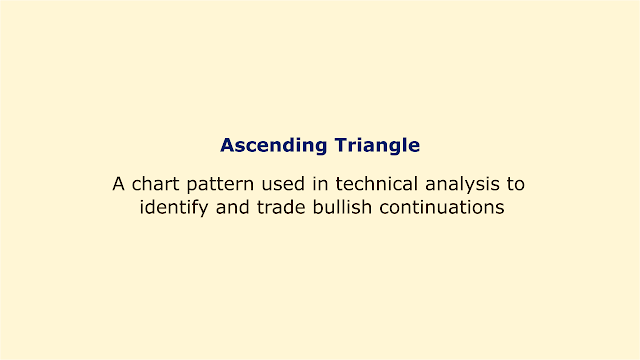 |
| Image: Moneybestpal.com |
The ascending triangle is a chart pattern used in technical analysis to identify and trade bullish continuations. It consists of a descending line that joins the swing lows and a horizontal line that joins the swing highs.
The triangle formed by the two lines illustrates the growing purchasing pressure as the price makes higher lows.
The ascending triangle is frequently considered a continuation pattern, which means that it confirms the trend's direction. At the bottom of a downtrend, it can also show up as a reversal pattern, signaling that the buyers are taking control and the sellers are waning in strength.
The ascending triangle can be traded since it offers distinct levels for entry, exit, and stop loss. The beginning of a fresh uptrend is indicated by a breakout above the horizontal line, which is what traders watch for. Increased volume should follow the breakout, which validates the pattern's validity.
Traders can measure the height of the triangle at its widest point and add that measurement to the breakout point to determine the ascending triangle's profit target. The height of the triangle, for instance, is $10 if the horizontal line is at $50 and the rising line begins at $40. The profit goal is $60 ($50 + $10) if the price breaks out over $50.
Each trader's risk appetite and trading style will affect the ascending triangle's stop loss level. Some traders could set their stop loss below the rising line, while others might set it below the most recent swing low. Respecting the risk-reward ratio and not taking on more risk than what can be made on the trade is crucial.
The ascending triangle is a dependable and simple-to-recognize pattern that can assist traders in identifying bullish continuations or reversals. Traders can profit from this pattern and raise their chances of success by adhering to the principles of entry, exit, and stop loss.
The ascending triangle is frequently considered a continuation pattern, which means that it confirms the trend's direction. At the bottom of a downtrend, it can also show up as a reversal pattern, signaling that the buyers are taking control and the sellers are waning in strength.
 |
| Image: TradingView |
The ascending triangle can be traded since it offers distinct levels for entry, exit, and stop loss. The beginning of a fresh uptrend is indicated by a breakout above the horizontal line, which is what traders watch for. Increased volume should follow the breakout, which validates the pattern's validity.
Traders can measure the height of the triangle at its widest point and add that measurement to the breakout point to determine the ascending triangle's profit target. The height of the triangle, for instance, is $10 if the horizontal line is at $50 and the rising line begins at $40. The profit goal is $60 ($50 + $10) if the price breaks out over $50.
Each trader's risk appetite and trading style will affect the ascending triangle's stop loss level. Some traders could set their stop loss below the rising line, while others might set it below the most recent swing low. Respecting the risk-reward ratio and not taking on more risk than what can be made on the trade is crucial.
The ascending triangle is a dependable and simple-to-recognize pattern that can assist traders in identifying bullish continuations or reversals. Traders can profit from this pattern and raise their chances of success by adhering to the principles of entry, exit, and stop loss.
